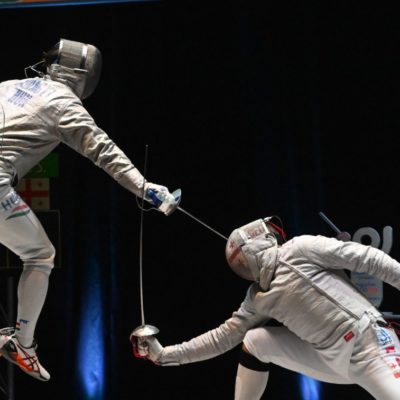Recently, the Italian foilists have been doing very well internationally,
winning competition after competition. To win these competitions, they have to
win a lot of bouts, and to win a lot of bouts, they have to score a lot of
points. So let’s talk about how they are getting points and what we can learn
from them.
In this analysis, Brandon Smith investigates the mysteries of “Italian
tempo.”
What can we learn from the Italian men’s foil team?
In my view, one of the Italians’ greatest strength is their use of tempo in fencing. I’m not going to empirically define tempo, because I think fencing is more art than science — just read along and “work with me.”
If you have ever played a musical instrument, then you know what I’m talking about. Every song has a tempo, or a rhythm, or a beat. It is pretty clear when you look at the notes on the page — you know how many beats per bar, how long the beats are, whether the song is supposed to be played fast or slow or in-between, and when the speed is supposed to change. Well, fencing also has a tempo, but it is not as easy to understand because there isn’t a metronome or sheet of paper you can refer to like in music.
Fencing Tempo explained
A fencer transfers weight from one foot to the other and back again during footwork. We are all two-legged creatures and cannot move around without transferring weight from leg to leg. So while it may look like an excellent fencer is “gliding” forward or backwards, there is still a continuous transfer of weight between the feet. Recognizing this is critical to understanding tempo in a fencing action.
When a fencer makes a step forward, he first lifts up his front foot, puts weight on his back leg and pushes forward. At the end of the step, he touches down with the front foot and absorbs the forward momentum on the front leg. So, if you launch a direct attack into a marching fencer when their weight is on their rear leg, that means that all he has to do to hit you is keep pushing on that rear leg and finish the attack — one tempo. However, if you launch the attack when his weight is on his front foot, he must first switch his weight to his rear leg, re-lift his front foot and then finish his attack — two tempos. So what may appear as "smooth steps forward" to a low-level fencer, a high-level fencer can dissect and find holes to exploit.
What about offensive tempo?
Tempo can also be used offensively. Because high-level fencers expect that their opponents understand defensive tempo, and expect their opponents to try to dissect their attacks as above, the attacker can also play a game of “smoke and mirrors” — showing their steps to indicate holes. Fencers can pretend to move too fast in the beginning and then change speeds mid-attack; they can lunge short on purpose to confuse the opponent; they can walk forward with blade up in air and then go direct, etc.
Italian Tempo
In my observation, the Italian game used to be mainly about defensive tempo. In the 80’s and early 90’s, Numa (master of the attack in preparation) and Borella (master of the point-in-line in preparation) were prime examples. They would dance around and around, frustrating their opponents and waiting for exactly the right time to score into their opponents attack. They seemed to be able to find holes in even the most classical masters (Romankov, Omnes, etc).
These days (maybe because of the emergence of flicks), the Italian game has evolved into offensive tempo. Cerioni, Sanzo, Zennaro, Vanni, Cassara — these fencers try to score points by putting pressure on their opponents right from the “allez”.
They don’t sit back and wait for their opponents — they get in their face, push them to the end of the strip, launch attacks without any preparation. They know that the more “room” they give their opponents to breathe, the more chance they will be taken advantage of. Interestingly, Goloubitski remarked that fencers of today don’t spend time in the beginning of a bout to “feel out” their opponent — they just rush in. This is very true of the Italian team — but perhaps they are just making sure that their opponent does not feel them out. A good offence is sometimes the best defense.
Let me ask a question: If you did not have to step, but could float around on a magic Frisbee in foil fencing, how well would you do? Think of it! You could control the speed, direction, and acceleration of your Frisbee on the piste at will. All you would have to worry about is your hand, making sure to stick it out or parry at the right time, the Frisbee would take care of all your movement. I think you would do pretty well.
Salvatore Sanzo‘s fencing is not unlike this. In many of his matches, his feet rarely come within one meter of each other. He does not allow his opponent the luxury of a seeing a two-part step forward or back — he does more of a shuffle with his feet — so his legs don’t move.
This means that he will hardly ever be caught with an attack in preparation and he can launch his final lunge at anytime he desires, not just when his step is complete. Effectively, he negates the weight changes in his movement — like the magic Frisbee would. This kind of abbreviation can be very useful in fencing.
Like Andre Agassi, whose abbreviated tennis swing catches opponents off-guard; Sanzo has evolved the standard step-forward into a “shift-forward”. This means that he can keep shifting forward putting the pressure on without offering his opponent a real chance to attack into it.
Many epee fencers already perform this kind of shifting footwork, but it is rare in foil, where long phrases stretch up and down the piste, and therefore big steps are more common. Sanzo seems to be able to fuse shifting footwork and foil phrases into one.
Sanzo is all about right-of-way (RoW) domination. From beginning to end of his matches, he tries to take and keep RoW at every turn — he won’t let his opponent have RoW, let alone score a point.
He throws out lines, swings at blades, does stutter-steps backwards — anything to break his opponents’ attacks and take back RoW. And once he has it, he doesn’t give it away. Sanzo is one of the hardest working guys in fencing and is willing to motor forwards and backwards as many times as it takes to get his hit. The Italian word for lazy is not in his vocabulary.
Here is another interesting point about Sanzo: you will never see his front leg bend past about 110%, even at the completion of his lunge. He lunges with extreme power, but that power is in a short burst that ends quickly. The effect is that even if you have parried his attack, he will still be in good balance and difficult to riposte against. If he falls short, he will be instantly ready to launch another attack (which is bad for you because you have already backed up to avoid the first attack and are probably at the end of the piste).
Use of tempo sets Italy apart
Reviewing match after match of Sanzo, Vanni, and Cassara, I did find one element that was common to all: Almost every attack they make has multiple speeds built in — this is the one point that really sets the Italians apart from fencers of other countries.
You won’t see Sanzo doing a pretty double-disengage to get around a fast set of parries; you won’t see Vanni doing a opposition attack binding his opponent’s blade; you won’t see Cassara doing a classic beat disengage attack.
However, you will see supreme creativity in speed changes during their attacks — and it’s not just combinations of “fast” and “slow”, which seems to be the extent of most mediocre fencers’ abilities.
You will see their opponents get hit with very simple actions and wonder, “Why would a guy of that ability get hit with such a simple move?” You will see their opponents unable to keep up with the changes in tempo and get frustrated and desperate. You will see their opponents miss touches that they would score on most anyone else.
Like any great artist, the Italian foilists seem to use a “spectrum of flavors” when it comes to tempo. Here are some Italian words and English meanings describing tempo used in music:
Largo | Broad | Slow and dignified |
Larghetto | a little bit broad | Not as slow as largo |
Lento | Slow | Slow |
Adagio ad agio | at ease | Slow, but not as slow as largo |
Adagietto | little adagio | Faster than adagio; or a short adagio composition |
Andante | Walking | Moderately slow, flowing along |
Comodo | comfortable | At moderate speed |
Allegretto | a little bit joyful | Slightly slower than allegro |
Allegro | joyful | Moderately fast |
Presto | ready | Very fast |
Prestissimo | very ready | Very very fast |
Accelerando | accelerating | Accelerating |
Affrettando | becoming hurried | Accelerating |
{mosimage} It’s ironic that although even beginning foil fencers in most countries know 9 parries, 9 counter parries, many disengages, lunges, step lunges, fleches, etc., we only have two basic speeds — fast and slow. How many times have you heard a coach say “Start your attack slow, then finish fast”? I think there is more to it.
There is so much more to learn and study about tempo than most coaches teach. Can you imagine how confused and helpless your opponent would be if you could deftly mix and match among the above 13 tempos at will? If you could do that, you would not need refined point feints to deceive your opponent — the tempo would do the job for you.
I will be the first to admit that I don’t know what the “right” combinations are. But I hope that by bringing attention to this mostly unexplored territory, we will all be able to grow as fencers. Tempo is how the Italian men’s foilists dominate the fencing world, and how any fencer can add another dimension to his or her game.
So next time you get on the strip, why not try a Comodo approach, into a Adagio preparation, and finish with a Presitissimo lunge? Or perhaps an Andante opening with an Allegro middle and Affrettando finish? The choices are endless.
Good luck and good fencing!
Brandon Smith is a foil fencer poking about in Tokyo, Japan. He was a member of the 1993 Canadian Pan American team and 1995 University Games.





